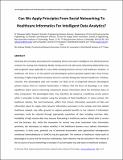| dc.contributor.author | Shields, Andrew | |
| dc.contributor.author | Datta, Shoumen | |
| dc.date.accessioned | 2008-12-14T15:57:31Z | |
| dc.date.available | 2008-12-14T15:57:31Z | |
| dc.date.issued | 2008-12-14T15:57:31Z | |
| dc.identifier.uri | http://hdl.handle.net/1721.1/43944 | |
| dc.description | Ubiquitous sensor networks have the potential to generate vast streams of data. Making sense of the data represents a considerable challenge. In one approach, some may react only to exceptions. A low-level data mining layer may abstract data into “cubes” of information suitable for reality mining agents to analyse and catalyse decision support. The future of an integrated reality-online analytical framework may concomitantly support remote experts, real-time teams and insight-based or intelligence-trained feedback for point-of-contact (POC) decision makers to improve patient-specific services.
The ill-formulated amorphous challenge presented in this working paper relies on (and expects to trigger further development by) individuals who have a breadth of interest and are gifted with the ability to construct fruitful analogies between fields while extracting pragmatic applications to balance cost versus ethics while serving the vastly divergent domains spanned by healthcare: healthcare industry economics conscious of cost and healthcare as a patient-centric service defined by ethical globalization. | en |
| dc.description.abstract | Extracting the principles associated with complexity theory and swarm intelligence has offered practical solutions for routing and scheduling. Reality mining and its link with social networking relationships may yield pragmatic ideas applicable to many fields including business services and healthcare analytics. In healthcare, the focus is on the patient and physiological systems generate patient data. Since human physiology is highly integrated and always strives to maintain biologically relevant equilibrium, it follows, naturally, that physiological data and variables are likely to be co-integrated. Because physiological systems always strive to maintain homeostasis, it follows, that the focus of physiology is to attain equilibrium where various interacting components possess information about the functional status of other components. The physiological state, may, therefore, be viewed as a healthcare service system which is amenable to data analytics using the principles of Nash Equilibrium. In sharp contrast, the healthcare industry, like most businesses, suffers from chronic information asymmetry of data and information about its supply chain network. Information asymmetry in the complex and inter-related healthcare network may offer grounds to explore potential benefits to the industry if information asymmetry could be reduced through appropriate acquisition of data including real-time data. Availability of high volume data may improve forecasting in healthcare sectors related both to service and the business. But, while the innovation for service may draw inspiration from information symmetry, the techniques to reduce volatility in the healthcare business must address information asymmetry. In both cases, potential use of advanced econometric tools (generalized autoregressive conditional heteroskedascity or GARCH) may be applicable. The network in healthcare relates both to physiological circuitry and the business relationships. Both networks may be evaluated in the context of the structures of social networking to elucidate if such principles may add value to healthcare analytics. | en |
| dc.description.sponsorship | MIT Forum & CIDS | en |
| dc.language.iso | en | en |
| dc.subject | Intelligent Decision Systems, Systems Engineering, Remote Monitoring, Glucose Sensors, ICT, Semantics, Informatics, Analytics, Electronic Medical Records, EMRS, Interoperability, Mash-Up, SOA, Agents, AI, Biomarkers, Cardiovascular Diseases, Early Detection, Preventative Medicine, Social Networking, Reality Mining, Data Mining, Linguistics, RFID, Supply Chain Management, WSN, Nash Equilibrium, Information Asymmetry, Generalized Autoregressive Conditional Heteroskedasticity, VAR, ARMA, Nano-sensors | en |
| dc.title | Can We Apply Principles From Social Networking To Healthcare Informatics For Intelligent Data Analytics? | en |
| dc.type | Article | en |
| dc.contributor.department | Massachusetts Institute of Technology. Auto-ID Laboratory | |
